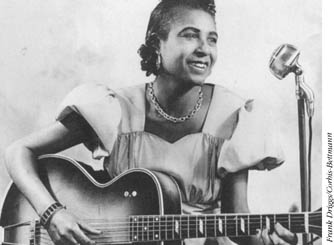
Memphis Minnie was one of the first female blues musicians to leave a mark on the genre.
Lizzie “Memphis Minnie” Douglas was one of the handful of women to gain fame in the maledominated world of the blues musician. She could play as well as any male blues guitarist, and was a renowned composer and singer whose loud, authoritative voice could be heard over any band. She was also one of the few musicians to successfully make the transition from the rural guitar-dominated blues of the 1920s to the urban nightclub styles of the 1930s.
Douglas was born on June 3, 1897, in Algiers, Louisiana, the oldest of 13 children. Her family moved to Wall, Mississippi, just outside Memphis, when she was seven. Three years later, her father bought her a banjo, and within a few years she was accomplished on both banjo and guitar. By age 15, she was singing o n the Memphis street corners using the nickname “Kid Douglas,” and in 1916 became a musician for the Ringling Brothers Circus and travelled around the South. Minnie landed back in Memphis in the 1920s, where she played juke joints (drinking establishments with dancing to a jukebox) and house parties. She usually played with a male partner on second guitar, following the Memphis guitar duo tradition, which featured two distinctive musical lines that meshed with one another.
Minnie was partnered with Mississippi bluesman Joe McCoy when a Columbia Records talent scout discovered her in 1929- Later that year she and McCoy recorded in N ew York as Memphis Minnie and Kansas Joe. Their first release, the sexually themed “Bumble Bee,” was a hit, and Minnie recorded four different versions of the song. Minnie and Kansas Joe cut several dozen blues songs over the next five years, with Minnie usually on vocals. Other hits included “Hoodoo Lady” and “I Want Something for You.” Her singing style, unlike that of the classic blues singers, was grounded in country blues and filled with rough-edged passion.
Minnie and McCoy married and moved to Chicago in 1930. By 1935 they had separated, and about this time Minnie made the transition to a more urban sound, working with rhythm sections on music made for jukeboxes and dancing. In 1939 she married Memphis guitarist Ernest Lawlars, known as Little Son Joe, and in 1941 Minnie had an electric guitar hit with “Me and My Chauffeur.” She signed on with Chicago publisher and producer Lester Melrose, and recorded for various labels in the 1940s and early 1950s, both with Joe and with a combo. Her music also became a staple at the Grand Ole Opry when country singer Lew Childre recorded a version of Minnie’s “Fishin’ Blues” in 1936 and frequently performed it there.

Memphis Minnie was one of the first female blues musicians to leave a mark on the genre.
In the mid-1950s, Minnie retired and moved back to Memphis. Joe died in 1961 and Minnie suffered a stroke not long afterward. She died on August 6, 1973. In 1980 she was inducted into the Blues Foundation Hall of Fame.
Stan Hieronymus
SEE ALSO:
BLUES; COUNTRY; RAINEY, MA; SMITH, BESSIE.
Cohn, Lawrence. Nothing But the Blues (New York: Abbeville Press, 1993)..
Garon, Paul, and Beth Garon. Woman with Guitar: Memphis Minnie’s Blues ( New York: Da Capo Press, 1992).
Hoodoo Lady 1933–37; I Ain’t No Bad Gal; Memphis Minnie.